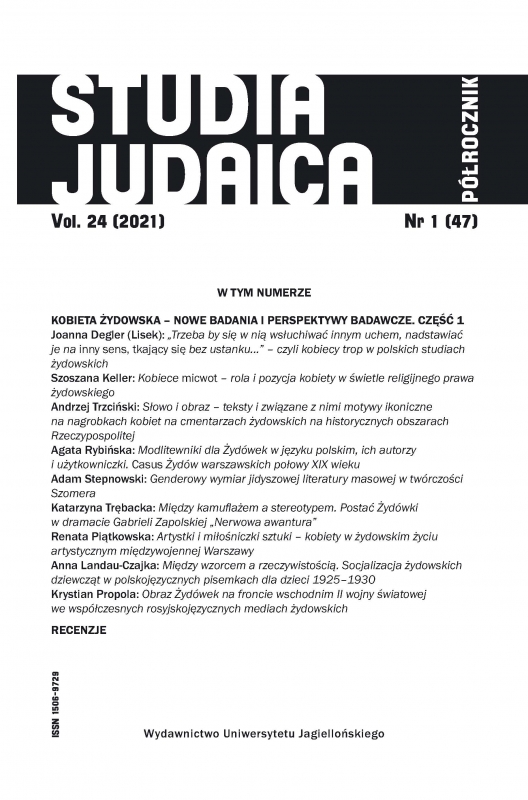Słowo i obraz – teksty i związane z nimi motywy ikoniczne na nagrobkach kobiet na cmentarzach żydowskich na historycznych obszarach Rzeczypospolitej
Word and Image: Texts and Related Iconic Motifs on Women’s Gravestones in Jewish Cemeteries in the Historical Areas of The Republic of Poland
Author(s): Andrzej TrzcińskiSubject(s): Jewish studies
Published by: Wydawnictwo Uniwersytetu Jagiellońskiego
Keywords: Jewish woman; Jewish tombstones; sepulchral symbolism; iconology
Summary/Abstract: The aims of this study are the following: to distinguish thematic groups, determine the range of iconic motifs used and the chronology and frequency of their occurrence, as well as to juxtapose them with normative content from religious writings of Judaism and with rites and customs.The following conclusions emerge from the research: In the early period (until the fourth quarter of the eighteenth century), there was no differentiation on tombstones between separate motifs ascribed to men (except for the Kohanim and Levites) and separate motifs ascribed to women. Among the common motifs, the bird motif dominated on women’s gravestones, while the crown motif acquired its specific character. In the fourth quarter of the eighteenth century, the motif of a candlestick appeared on women’s gravestones; it spread very quickly and became a visual identification feature. In the nineteenth century, with the introduction of vanitas motifs on gravestones, they began to be used on women’s gravestones. The connection of motifs with the names of the deceased is also noticeable (e.g. Feigl–bird, Rachel–fairy, Royza–rose, or scenes related to biblical namesakes). The contents of women’s epitaphs presented as praise or description of virtues largely concern traditional female duties toward the home, husband, and children. Women’s gravestones contain no attributes or references to the study of Torah and scholarship, or else to activities in the public sphere—to professions, both religious and later secular—which obviously results from the position and role of women in the patriarchal community. Such information does not appear until the interwar period on the tombstones of women from families assimilated into the surrounding culture which is also evidenced by non-traditional tombstone forms and inscriptions in non-Jewish languages.
Journal: Studia Judaica
- Issue Year: 24/2021
- Issue No: 47
- Page Range: 41-97
- Page Count: 57
- Language: Polish

